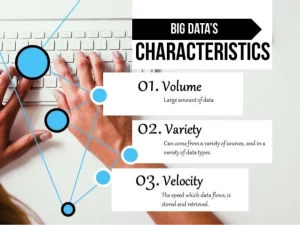What Is Big Data?
Big Data refers to vast datasets that encompass various types of data—structured, unstructured, and semi-structured. These datasets can be collected, stored, and analyzed to derive valuable insights for organizations, driving decision-making and strategic planning.
The potential of Big Data is intrinsically linked to effective data management. Traditionally, data was organized using relational models within data warehouses and managed through ETL (Extract, Transform, Load) processes. However, the sheer scale and complexity of Big Data have necessitated the adoption of new methods, such as NoSQL and non-relational databases, fundamentally changing conventional data management practices.
Key Characteristics of Big Data

The Data Management Body of Knowledge (DMBOK) highlights six key attributes that are crucial in understanding the scope and challenges of Big Data. These attributes serve as a framework for organizations to recognize the intricate nature of Big Data and adopt appropriate strategies for effective management and analysis. Let’s delve into an explanation of each attribute:
Volume
The term “Volume” epitomizes the core essence of Big Data. We’re talking about data sets so immense — encompassing billions of records or instances — that they render traditional database management systems inadequate. This characteristic isn’t just about the sheer quantity of data; it’s about the space it demands for storage and the computational power required to process it. Volume sets Big Data apart from regular data sets, necessitating more robust, scalable solutions for storage and analysis.
Velocity
“Velocity” refers to the rapid rate at which data is produced, collected, and the need for its immediate analysis and application. In today’s fast-paced digital world, data streams continuously from various sources like social media, business transactions, and IoT devices, among others. This rapid flow of data enables organizations to perform real-time analytics, meaning they can make informed decisions almost instantaneously based on the latest information, enhancing responsiveness and agility in business operations.
Variety/Variability
Big Data encompasses a “Variety” of formats — from structured numerical data in databases to unstructured text documents, emails, videos, audios, stock ticker data, and more. The “Variability” in data types presents significant challenges in processing and analysis, as different techniques are required to extract meaningful information from each type of data. This diversity requires versatile data integration techniques to ensure all data, regardless of format, can be analyzed cohesively.
Viscosity
The concept of “Viscosity” addresses the flow and integration of data into an organization’s existing data systems. High viscosity indicates that data is thick and slow-moving, making it difficult to merge with existing data pools due to its complexity or varied formats. This can create bottlenecks in data processing and analysis, requiring more sophisticated methods to ensure smooth data integration and usability.
Volatility
“Volatility” deals with how rapidly data becomes outdated or irrelevant. Given the dynamic nature of Big Data, the information lifecycle can be incredibly short. Organizations need to constantly update, archive, or discard data to keep their analyses relevant and timely. The ability to manage data’s volatility efficiently is crucial in maintaining the accuracy and usefulness of business insights.
Veracity
Lastly, “Veracity” touches on the trustworthiness and accuracy of data. In a Big Data environment, ensuring the quality and reliability of data can be challenging, especially given the volume and variety of sources. However, veracity is critical because the decisions derived from Big Data analytics are only as good as the data itself. Organizations must implement robust data verification and validation techniques to maintain high data quality for reliable analytics.
In conclusion, DMBOK’s key attributes of Big Data—Volume, Velocity, Variety/Variability, Viscosity, Volatility, and Veracity—underscore the complexities and considerations necessary for effectively managing and leveraging Big Data. Understanding these attributes is essential for organizations aiming to harness the power of Big Data for analytical insights and informed decision-making.
Perspectives on Big Data

The term “Big Data” encompasses a broad and multifaceted concept that various industry experts and entities describe in different ways, each emphasizing unique aspects and implications of Big Data’s role in the modern technological and business landscapes. Here’s a detailed explanation of these perspectives:
Gartner
Gartner, a leading research and advisory company, defines Data through three defining characteristics: high volume, high velocity, and variety. This definition focuses on the scale of data, the speed at which it’s generated processed, and the range of data types and sources. Gartner underscores the necessity for cost-effective processing methods to unlock enhanced insights and informed decision-making, emphasizing the challenges and opportunities presented by managing large, fast-moving, and complex data sets.
Dr. Peter Aiken
Dr. Peter Aiken, an acknowledged data management guru, introduces the concept of “Vitality” to the Big Data discussion. Vitality refers to the need for continuous analysis and the application of predictive modeling within dynamic data environments. This perspective highlights the evolving nature of data and the necessity for businesses to adapt their analytical processes to remain relevant and forward-looking.
Forrester
Forrester Research, a well-respected market research company, views Big Data as a disruptive force within the realms of business intelligence and data management. This disruption is reshaping how organizations govern their data and deliver IT services, bringing to the forefront challenges related to handling vast amounts of data and requiring shifts in traditional data management strategies.
Forbes
Forbes, a global media company, recognizes Big Data as a key driver of digital transformation. This view emphasizes the role of Big Data in integrating leading-edge technologies such as Artificial Intelligence (AI) and the Internet of Things (IoT) into business operations. Forbes suggests that Big Data not only supports but actively stimulates the integration of these technologies, transforming how businesses operate and compete.
Oracle
Oracle, a major player in the tech industry, offers a holistic view of Big Data, encompassing both traditional databases and emerging data forms within a comprehensive information management strategy. This perspective acknowledges the diversity of data types and the need for inclusive strategies that enable organizations to leverage all forms of data for competitive advantage.
Daisy Ridley
The perspective attributed to Daisy Ridley highlights the sociological impact of Big Data, specifically its potential to create jobs. By enhancing the speed and transparency of processes, Big Data can drive efficiencies and innovations that result in new employment opportunities across various sectors.
O’Reilly
O’Reilly, a learning company known for its insightful tech publications, characterizes Big Data as datasets that surpass the processing capabilities of traditional database systems. This succinct definition points to the technological challenge at the heart of Big Data—managing data sets so large and complex that they defy conventional data processing tools and methods.
Each of these definitions sheds light on different facets of Big Data—from its technical challenges and the necessity for innovative management strategies, to its role in driving digital transformation and its societal impacts. Collectively, they paint a comprehensive picture of Big Data as a pivotal element of the contemporary digital landscape, essential for strategic decision-making, innovation, and sustaining competitive advantage in the information age.
Applications of Big Data
Big Data is a transformative force across various sectors, providing organizations with the tools to unlock numerous strategic advantages. Here’s a deeper analysis of how Big Data presents these opportunities:
Reducing Costs
Optimizing processes through the analysis of large datasets enables organizations to identify inefficiencies and bottlenecks within their operations. For example, by analyzing logistical data, a company can find the most cost-effective routes and methods of shipping. This level of operational efficiency not only streamlines processes but also significantly lowers expenses related to wasted time, resources, and effort.
Fostering Innovation
Big Data acts as a catalyst for innovation. By analyzing vast and diverse datasets, organizations can uncover hidden patterns, trends, and correlations that were previously unnoticed. These insights can spur the development of new products, services, or processes that can differentiate a company in the marketplace. For instance, a retailer could use customer purchase data to design personalized product offerings, enhancing the customer experience.
Identifying Business Opportunities
Through Big Data analytics, companies can detect emerging trends and niches in the market. By staying ahead of these trends, organizations are well-positioned to capitalize on new business opportunities. This could range from expanding into new markets, developing products for an emerging need, or optimizing existing offerings to better meet customer expectations.
Developing Predictive and Prescriptive Models
Predictive models utilize historical data to forecast future events, while prescriptive models suggest actions to achieve desired outcomes. Together, these models enrich an organization’s strategic planning and operational decision-making. For example, a financial institution could use predictive models to assess loan risk and prescriptive analytics to optimize investment strategies for its clients.
Targeting Customers Effectively
Big Data enables refined segmentation of customer bases, allowing for more targeted and effective marketing strategies. By understanding specific customer behaviors and preferences, companies can tailor their communications and offers, significantly improving engagement and satisfaction. This personalized approach not only enhances the customer experience but also increases the effectiveness of marketing budgets.
Optimizing Decision-Making
Access to comprehensive and timely data equips decision-makers at all levels of an organization with the insights needed to make informed choices. This data-driven approach minimizes guesswork and biases, leading to more strategic and effective decisions. Whether it’s determining the next quarter’s budget allocations or choosing a new market to enter, data provides a solid foundation for these decisions.
Enhancing Enterprise-Wide Performance
Big Data analytics can drive improvements across the organization’s entire spectrum of activities. By leveraging insights derived from data, companies can enhance productivity, customer service, and operational efficiency, thereby improving overall performance and competitiveness in the market. For instance, analyzing production data could reveal opportunities to increase manufacturing throughput without sacrificing quality.
Improving Data Security and Compliance
In today’s digital age, data security and regulatory compliance are paramount. Big Data tools can monitor and analyze network traffic to detect potential security breaches in real-time. Moreover, they can ensure that an organization’s data handling practices are in compliance with relevant laws and regulations, thereby mitigating risks and liabilities.
In essence, the strategic utilization of Big Data enables organizations to not only navigate the complexities of the modern business landscape but to thrive within it. Through enhanced insights, improved efficiency, and heightened innovation, Big Data offers a pathway to sustained competitive advantage.
Conclusion
Big Data is not just a buzzword; it represents a transformative force in the business landscape. Understanding its characteristics, potential applications, and the evolving data management practices is essential for organizations seeking to leverage this powerful resource. By effectively managing and analyzing Big Data, businesses can unlock valuable insights that drive growth, innovation, and success in an increasingly data-driven world.











